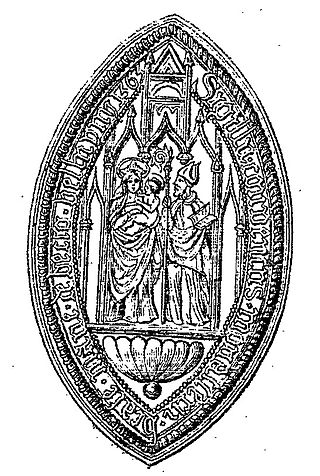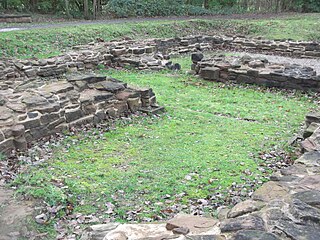
Canterbury Cathedral is the cathedral of the archbishop of Canterbury, the spiritual leader of the Church of England and symbolic leader of the worldwide Anglican Communion. Located in Canterbury, Kent, it is one of the oldest Christian structures in England and forms part of a World Heritage Site. Its formal title is the Cathedral and Metropolitical Church of Christ, Canterbury.

St Benet's Hall was a permanent private hall (PPH) of the University of Oxford, originally a Roman Catholic religious house of studies. It closed in 2022. The principal building was located at the northern end of St Giles' on its western side, close to the junction with Woodstock Road, Oxford.
Æthelnoth was the archbishop of Canterbury from 1020 until his death. Descended from an earlier English king, Æthelnoth became a monk prior to becoming archbishop. While archbishop, he travelled to Rome and brought back saint's relics. He consecrated a number of other bishops who came from outside his archdiocese, leading to some friction with other archbishops. Although he was regarded as a saint after his death, there is little evidence of his veneration or of a cult in Canterbury or elsewhere.
Simon de Langham was an English clergyman who was Archbishop of Canterbury and a cardinal.

Bec Abbey, formally the Abbey of Our Lady of Bec, is a Benedictine monastic foundation in the Eure département, in the Bec valley midway between the cities of Rouen and Bernay. It is located in Le Bec Hellouin, Normandy, France, and was the most influential abbey of the 12th-century Anglo-Norman kingdom.
Simon Islip was an English prelate. He served as Archbishop of Canterbury between 1349 and 1366.

The Priory of St. Mary the Virgin and St. Martin of the New Work, or Newark, commonly called Dover Priory, was a priory at Dover in southeast England. It was variously independent in rule, then occupied by canons regular of the Augustinian rule, then finally monks of the Benedictine rule as a cell of Christchurch Monastery, Canterbury.

Durham College was a college of the University of Oxford, founded by the monks of Durham Priory in the late 13th century and endowed by Bishop Thomas Hatfield in 1381.

Gloucester College, Oxford, was a Benedictine institution of the University of Oxford in Oxford, England, from the late 13th century until the dissolution of the monasteries in the 16th century. It was never a typical college of the University; in that there was an internal division in the college, by staircase units, into parts where the monasteries sending monks had effective authority. The overall head was a Prior, later changed to a Prior Studentium, and finally a Principal.

Thomas Chillenden was Prior of Christ Church Priory, Canterbury from 1391 to 1410. Under him, from 1391 to 1400, the Cathedral-Priory church's nave was rebuilt in the Perpendicular style of English Gothic architecture.
Nicholas Love, also known as Nicholas Luff, was first a Benedictine and then a Carthusian monk in medieval England, and became the first prior of Mount Grace charterhouse in Yorkshire. He was the translator and reviser of a popular devotional treatise which was used by the Church authorities to counter the teaching of John Wycliffe. In his later years he convinced Henry V of England to attempt to reform Benedictine monasticism in England, but died before measures could be taken.

Ampleforth Abbey is a monastery of Benedictine monks a mile to the east of Ampleforth, North Yorkshire, England, part of the English Benedictine Congregation. It descends from the pre-Reformation community at Westminster Abbey through the last surviving monk from Westminster, Sigebert Buckley. As of 2024 the monastery has 41 monks, and sometimes will have 50 nuns of the monastery organization.

Geoffrey was a 12th-century Anglo-Norman Benedictine monk and abbot. Of Anglo-Norman origin, he became monastic head of the Benedictine priory at Canterbury, before moving to Scotland to be the first Abbot of Dunfermline. As abbot he presided over the construction of the new monastery building, the immigration of English monks and settlers, and the accumulation of enough wealth to make Dunfermline Abbey the richest Benedictine monastic house in the Kingdom of Scotland.

Pamber Priory is a Church of England parish church and former priory, then known as West Sherborne Priory or Monk Sherborne Priory, at Monk Sherborne in the English county of Hampshire.

Sandwell Priory was a small medieval Benedictine monastery, near West Bromwich, then part of Staffordshire, England. It was founded in the late 12th century by a local landowner and was only modestly endowed. It had a fairly turbulent history and suffered considerably from mismanagement. It was dissolved in 1525 at the behest of Cardinal Wolsey – more than a decade before the main Dissolution of the Monasteries under Henry VIII.
Roger Norreis was Abbot of Evesham in England. He was a controversial figure, installed in several offices against opposition. In his appointment to Evesham, he was accused of immoral behaviour and failing to follow monastic rules. In 1202, Norreis became embroiled in a dispute with his monks and his episcopal superior the Bishop of Worcester; litigation and argumentation lasted until his deposition in 1213. He was then appointed prior of a subsidiary monastic house of Evesham, but was deposed within months, then re-appointed to the office five years later.

St Bernard's College was a constituent college of the University of Oxford. Founded by the Cistercian order in 1437 and dedicated to Bernard of Clairvaux, it was suppressed in Spring 1540 during the dissolution of the monasteries. Its buildings were later used to found St John's College, Oxford.

Edith Weston Priory was a small alien house of Benedictine monks in Edith Weston, Rutland. The French parent house of Abbey of Saint-Georges, Boscherville was founded by Ralf de Tanquerville, chamberlain to William the Conqueror, about the year 1050. By 1114 his son William donated the church and manor at Edith Weston, and a small cell of monks was set up to collect the rents and intercede for the founder's soul.

St Augustine's Abbey was a Benedictine monastery in Canterbury, Kent, England. The abbey was founded in 598 and functioned as a monastery until its dissolution in 1538 during the English Reformation. After the abbey's dissolution, it underwent dismantlement until 1848.
Stoke-by-Clare Priory was a Benedictine monastery in Stoke-by-Clare, in Suffolk, an alien priory, dependent on Bec Abbey, in Normandy. Reinstituted in 1124, the Priory was suppressed in 1415.


















